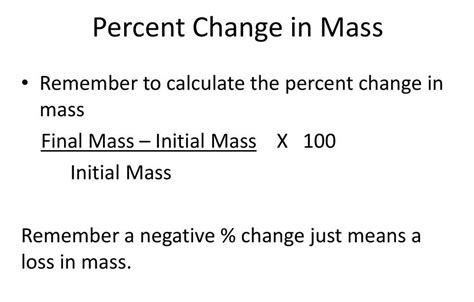The percent change in mass is a measure of how much the mass of an object has changed over time. It is calculated by dividing the change in mass by the original mass and multiplying the result by 100.

The formula for calculating the percent change in mass is:
% change in mass = (change in mass / original mass) x 100
For example, if an object originally has a mass of 100 grams and its mass increases to 110 grams, the percent change in mass is:
% change in mass = ((110 g - 100 g) / 100 g) x 100 = 10%
The percent change in mass can be used to track changes in the mass of an object over time. It can also be used to compare the mass of different objects.
Why the Percent Change in Mass Matters
The percent change in mass can be a useful metric for a variety of reasons. For example, it can be used to:
- Track the growth or decay of an object over time
- Compare the mass of different objects
- Determine the efficiency of a process
- Identify changes in the composition of an object
Benefits of Calculating the Percent Change in Mass
There are several benefits to calculating the percent change in mass, including:
- It is a simple and straightforward calculation
- It can be used to track changes in the mass of an object over time
- It can be used to compare the mass of different objects
- It can be used to identify changes in the composition of an object
Common Mistakes to Avoid
There are a few common mistakes that people make when calculating the percent change in mass. These mistakes include:
- Using the wrong formula
- Using the wrong units
- Not taking into account the precision of the measurement
Applications of the Percent Change in Mass
The percent change in mass can be used in a variety of applications, including:
- Chemistry: The percent change in mass can be used to track the progress of a chemical reaction.
- Biology: The percent change in mass can be used to track the growth or decay of an organism.
- Engineering: The percent change in mass can be used to determine the efficiency of a process.
- Environmental science: The percent change in mass can be used to identify changes in the composition of an object.
Conclusion
The percent change in mass is a useful metric that can be used in a variety of applications. It is a simple and straightforward calculation that can provide valuable information about the mass of an object.
Appendix
Tables
The following tables provide additional information about the percent change in mass.
| Term | Definition |
|---|---|
| Percent change in mass | A measure of how much the mass of an object has changed over time |
| Formula | (% change in mass = (change in mass / original mass) x 100) |
| Units | Percent (%) |
| Applications | Chemistry, biology, engineering, environmental science |
Additional Resources
- Percent Change in Mass Calculator
- How to Calculate Percent Change in Mass
- Percent Change in Mass: Applications and Examples
